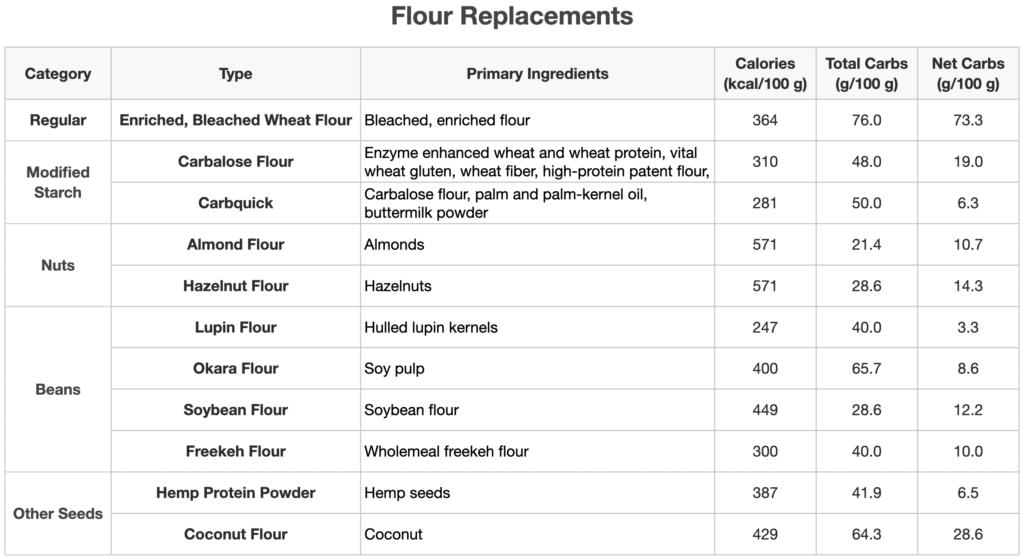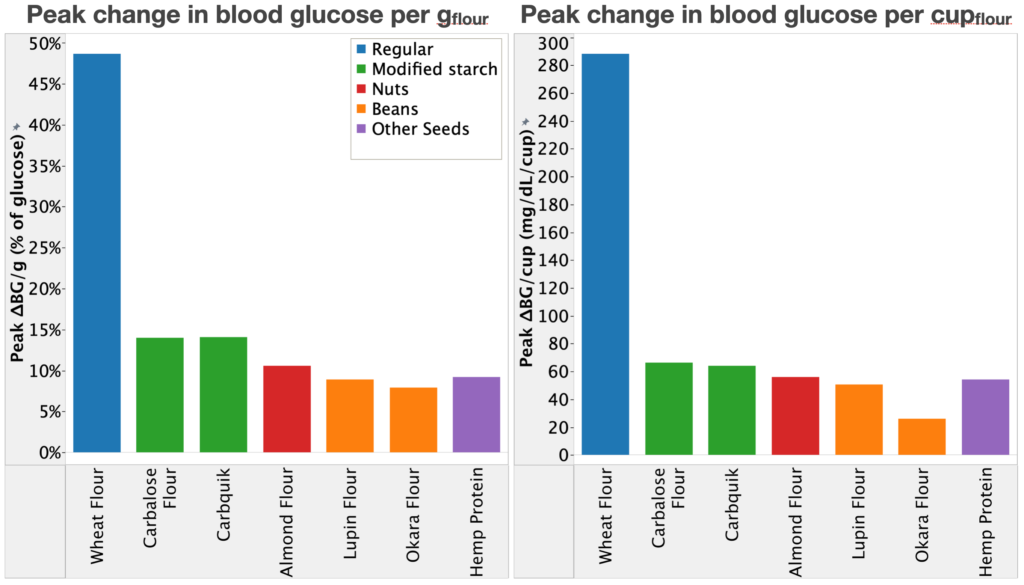Get new posts by email or rss feed
This post is an update on my experiments measuring the effect of low-carb foods and dietary supplements on blood sugar.
I’m still working my way through low-carb flour replacements, but since I’m running the vinegar experiment in parallel, it’s going to take a while to get through all of them.
In the meantime, I wanted to share my preliminary results and see if anyone has suggestions for additional low-carb flours to add to the study.
If you have any low-carb flour replacements you like or would like to see tested, please post it in the comments or send me a PM (contact form on the right).
Next week I’ll have an update on the vinegar experiments.
Testing Queue:
- Prepared foods:
- Tortillas: Reported
- Cereal: Reported
- Ice Cream: Reported
- Bread: Reported
- Meal replacements: in queue, (Ketochow reported)
- Snack bars: in queue
- Chocolate: Reported
- Ingredients:
- Macronutrients & sugar substitutes: Reported
- Flour replacements: Initial results, this post
- Seeds & nuts: in queue
- Vegetables: in queue
- Supplements:
- Vinegar: Initial replication, more experiments in queue
- MSG: Reported
Flour Replacements
When making low-carb baked goods, I find that the most difficult ingredient to replace is flour. Flour provides bulk, absorbs water, and binds ingredients together, creating the structure of most baked goods. Unfortunately, it’s ~75% starch by weight with a glycemic index of 70, resulting in an extremely high impact on blood sugar.
Historically, there hasn’t been a lot of low-carb replacements for flour available, mostly almond flour, coconut flour, and resistant starches. Similar to other low-carb products, a ton of new flour replacements have hit the market in the last few years. As always, the net carb counts look good, but I wanted to test them to see if they really hold up (see evidence of blood glucose impact of dietary fibers here & here).
So far, I’ve found 11 flours to test:
- Baseline:
- Wheat flour
- Modified starches
- Carbalose flour
- Carbquick
- Freekeh flour
- Nuts:
- Almond flour
- Hazelnut flour
- Beans:
- Lupin flour
- Okara flour (from soybeans)
- Other seeds:
- Coconut flour
- Hemp protein powder
- Flaxseed meal
- Psyllium husk powder

I’ve gotten through 7 so far and all have been pretty good, with peak ∆BG of 16-29% of wheat flour by weight and 9-23% by volume (see chart below).

As mentioned above, since I’m running the vinegar experiment in parallel, it’s going to take a while to get through the remaining flours. Once I do, I’ll post a full update with more detail on taste, texture, and the full blood glucose analysis.
In the meantime, since I’ve gotten such great recommendations from the readers, I wanted to solicit suggestions for additional low-carb flours to add to this study.
If you have any low-carb flour replacements you like or would like to see tested, please post it in the comments or send me a PM (contact form on the right).
I’ll test all the requests over the next couple weeks and post the results.
– QD
There is a white rice flour and brown rice flour. The white was good (I used in a lemon pound cake and added some blueberries) but it raised my BS. I have not yet tried the brown but hopefully it will be better than the white. I found this link to be interesting. I had no idea there were different flours for different things. https://www.nutritionadvance.com/types-of-flour/#:~:text=37%20Types%20of%20Flour%20and%20Their%20Nutritional%20Values.,Arrowroot%20Flour.%205%205%29%20Barley%20Flour.%20More%20items
That’s a great run-down of different flour options, thanks!
King Arthur has a “keto” flour that might be of interest. Claims about 13 g of net carbs per 100 g, if I did the math in my head correctly.
https://shop.kingarthurbaking.com/items/keto-wheat-flour
Oops. Did see that you had an update that includes this product. Thanks!
“Didn’t”
sigh